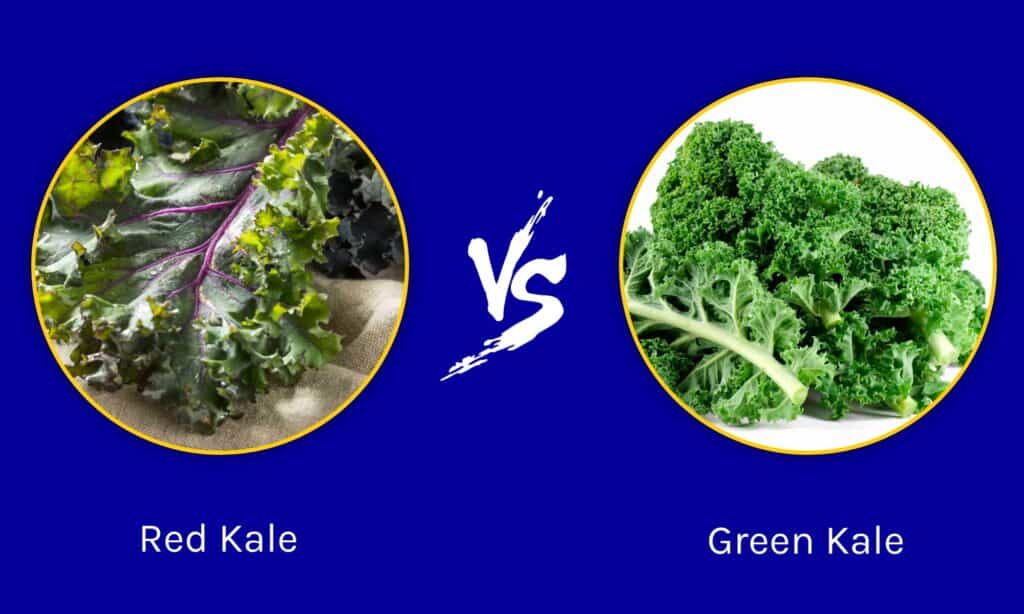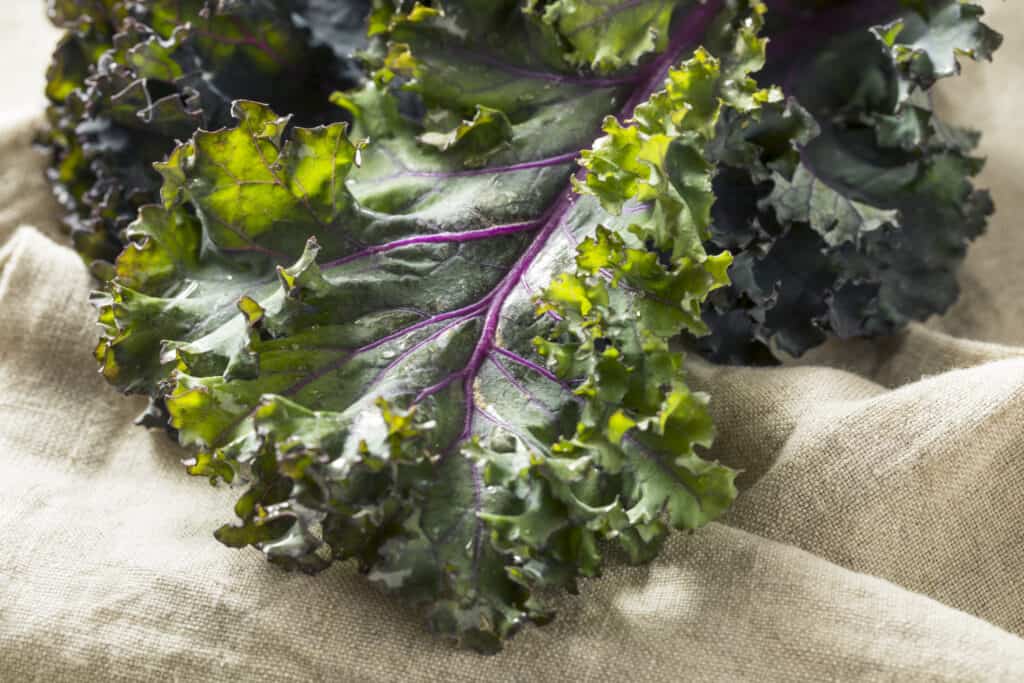Kale is a popular member of the cabbage family, known for its bold, somewhat bitter flavor. It is a rich source of vitamins, pantothenic acid, and several dietary minerals. Combined with the fact that it is easy to grow, it became pretty famous as an edible vegetable in the 1990s.
The plant’s leaves do not form a head — as with headed cabbage — and vary in color from yellow-green to white to reddish-purple. Although there are several kale cultivars scattered throughout the world, only three variations are commonly found in North American markets.
Among them, the best-known is “curly kale,” the type of green kale you’ll usually find in a grocery store. Another more uncommon variety of green kale is “Tuscan kale,” characterized by a deeper green color. Lastly, popping up here and there at more gourmet natural food stores is “Red Russian kale,” known for its dark purple stems and greyish-green leaves.
Further below, we’ll cover what makes them unique and why you should pick one over the other!
Comparing Red Kale vs. Green Kale

| Red Kale | Green Kale | |
|---|---|---|
| Classification | Species: Brassica napus Cultivar group: Pabularia Group | Species: Brassica oleracea (Brassica oleracea cv. Nero di Toscana, in the case of Tuscan kale) Cultivar group: Acephala Group |
| Common Names | Siberian kale, Ragged Jack kale | Scots kale, blue curled kale, lacinato kale, dinosaur kale |
| Native to | Northern Asia and Europe | Eastern Mediterranean and Anatolia |
| Description | — Height: 1 to 1 feet 6 inches tall— Oak-like greyish-green leaves and reddish-purple stems— Sweet and mild peppery flavor | — Height: 1 to 2 feet tall for Curly kale, 2 to 3 feet tall for Tuscan kale— Curled frilly pale to deep green leaves and light green stems— Bright, peppery, and mildly bitter flavor for Curly kale, mild and earthy sweetness for Tuscan kale |
| Uses | Often served raw in salads, soups, omelets, and even juices and smoothies. | Typically steamed and served in soups and purées, it can also be stir-fried and shredded into stews and various other recipes. |
| Growth and Harvesting | This variety should be planted in full sun and given half an inch of water a week; it grows best in colder conditions, preferably in the spring and fall; full-sized leaves can be harvested 50 days after sowing. | These varieties should be planted in sunny environments and given an inch of water per week; they grow best in temperate, slightly-cool climates; they are ready to pick about 60 days after being seeded. |
Key Differences Between Red Kale vs. Green Kale
Color isn’t the only differentiator between these healthy, delicious varieties of kale. They differ significantly in flavor and nutritional value, as well as in how they’re grown and where they originate from. We’ll delve into their key differences in the following sections!
Red Kale vs. Green Kale: Origin

Red kale stems from Siberia and parts of Northern Europe.
©iStock.com/bhofack2
Red kale stems from Siberia and parts of Northern Europe. Consequently, it is tremendously hardy and capable of withstanding cold temperatures. Russian traders introduced the variety to North America in 1885.
Among the green types, curly-leaved varieties of cabbage already existed in Greece and Anatolia as early as 2000 BC. Tuscan kale, another commonly found type of green kale in the U.S., dates to the 18th century in northern Italy.
Red Kale vs. Green Kale: Description

Red kale has reddish-purple stems and similarly colored veins on wavy-margined, slate-green leaves.
©iStock.com/bhofack2
Red Russian kale has reddish-purple stems and similarly colored veins on wavy-margined, slate-green leaves. Interestingly, cool weather intensifies and darkens its color. Mature plants are of medium height, and leaves are typically tender compared to other kales.
Curly kale shows green, tightly curled frilly leaves and thick, light green central stems. It grows up to 2 feet tall. Tuscan kale is mainly characterized by its slender, elongated, highly textured dark green leaves. It can grow up to 3 feet tall.
Red Kale vs. Green Kale: Growth and Harvesting

Green kale should be planted in full sun.
©iStock.com/Ockra
Red kale grows best in cold climates, though it can effectively grow in warmer temperatures. It should be planted in full sun, preferably from early spring to early summer. It needs about an inch of water per week, varying on the climate you’re growing it at. It’ll be ready for harvest when the leaves are about the size of your hand — typically around 50 days after sowing.
Green kale should also be planted in full sun, though these varieties can also grow in partial shade, needing about six to eight hours of light per day. Like red kale, they should be given an inch of water per week and preferably grown in slightly cooler climates. You should harvest them about 60 days after they are seeded.
Keep in mind that you can harvest them earlier — about 25 to 30 days after sowing — and still make great use of the “baby kale,” which is a nutritional powerhouse rich in calcium, iron, and vitamins.
Red Kale vs. Green Kale: Nutrition and Benefits
Red kale, like other kale varieties, is a low-calorie, low-fat, and low-carb food that supplies ample amounts of protein. It is also an excellent source of iron, magnesium, potassium, and dietary fiber. Eating it regularly may promote heart and eye health while preventing certain types of cancer.
Green kale, while containing almost identical nutrients to red kale, will provide substantial amounts of vitamins A, B6, K, and C. It is also impressively high in antioxidants like flavonoids and polyphenols, like other leafy greens. Including it in your diet will strengthen your bones and immune system.
Red Kale vs. Green Kale: Flavor and Uses

Some types of green kale have a strong bitter, peppery flavor when eaten raw.
©Amverlly/Shutterstock.com
Red Russian kale presents a slightly sweet and earthy, almost-nutty flavor. It is a great option to toss raw into salads, omelets, and soups. Some people even shred it and use it as a bitter ingredient for juices and smoothies.
Curly kale has a strong bitter, peppery flavor when eaten raw. Like many other leafy greens, it also presents an earthy taste. It can be eaten raw but is generally cooked or steamed into purées and soups. Many like stir-frying it in olive oil alongside onions and garlic, later mixing the concoction in salads and stews.
Tuscan kale comes with a deep, earthy flavor, albeit less bitter and with a nutty sweetness, similar to red kale. Like all other types of kale, you can eat it raw or cooked alongside other vegetables, later to become a salad or included as an ingredient in homemade recipes.
Up Next:
- Can Dogs Eat Kale? Is It Healthy or Toxic?
- Collard Greens vs. Kale: What’s the Difference?
- Kale Seeds: How to Grow and Harvest This Leafy Green
The photo featured at the top of this post is © Amverlly/Shutterstock.com
Sources
- Baza Agro, Available here: https://agro.icm.edu.pl/agro/element/bwmeta1.element.agro-e49626c4-abfe-4c5f-8ce7-f25df9f86dd7
- Digital Commons, Available here: https://digitalcommons.usu.edu/cgi/viewcontent.cgi?article=1274&context=extension_curall
- Almanac, Available here: https://www.almanac.com/plant/kale
- Gardener's Path, Available here: https://gardenerspath.com/plants/vegetables/grow-red-russian-kale/
Thank you for reading! Have some feedback for us? Contact the AZ Animals editorial team.






